IB9FJP - Leadership: Effective Leadership and Management Balance
VerifiedAdded on 2023/06/16
|13
|4080
|96
Essay
AI Summary
This essay provides a detailed analysis of leadership and management, highlighting their key differences, commonalities, and the challenges involved in balancing their demands within an organization. It discusses the concept of leaders as effective managers and the hurdles they face in achieving this. The essay also explores the demands of both leadership and management, offering tactics for striking a better balance between the two to ensure organizational success. The document is available on Desklib, a platform offering a wide array of study tools and resources for students.
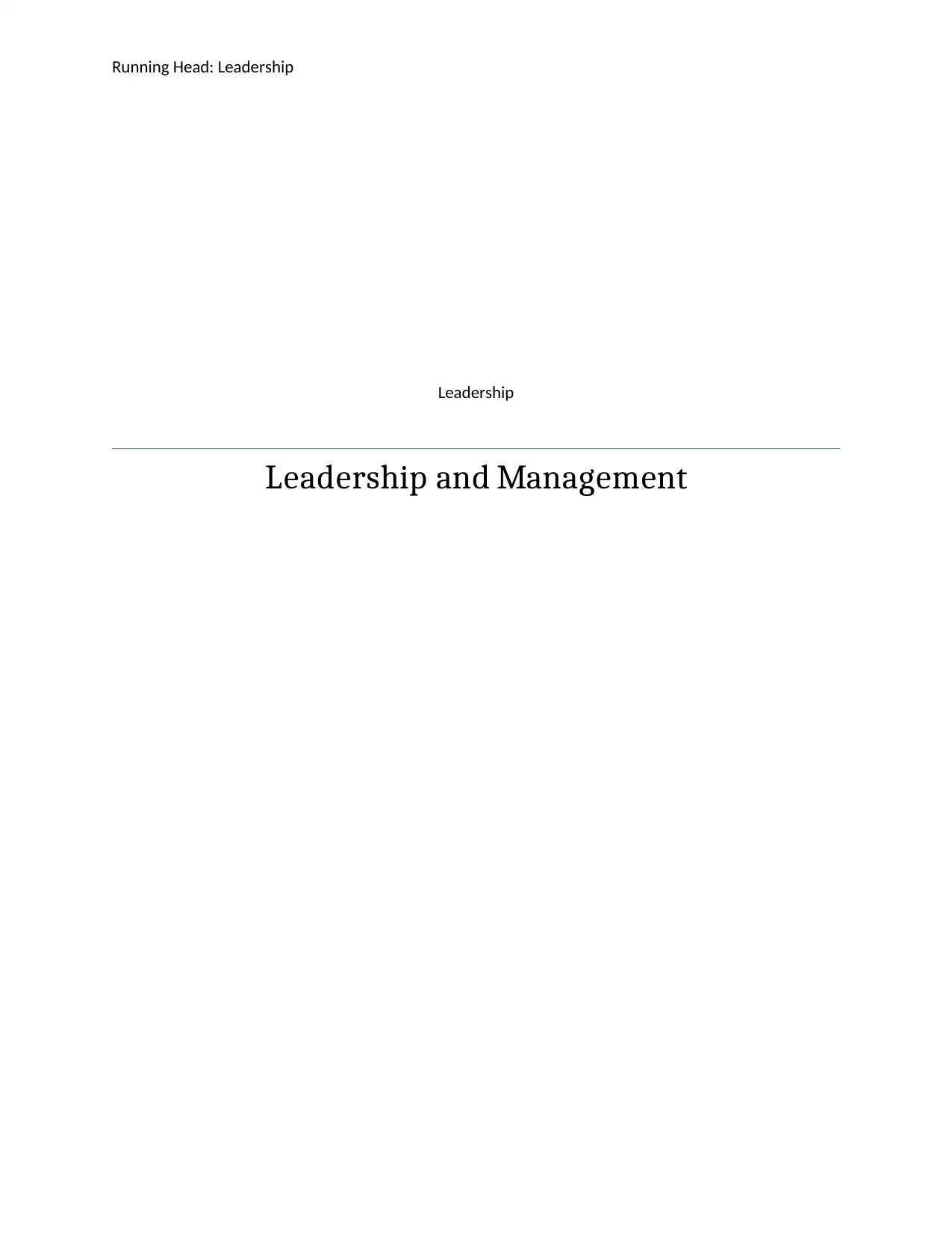
Running Head: Leadership
Leadership
Leadership and Management
Leadership
Leadership and Management
Paraphrase This Document
Need a fresh take? Get an instant paraphrase of this document with our AI Paraphraser
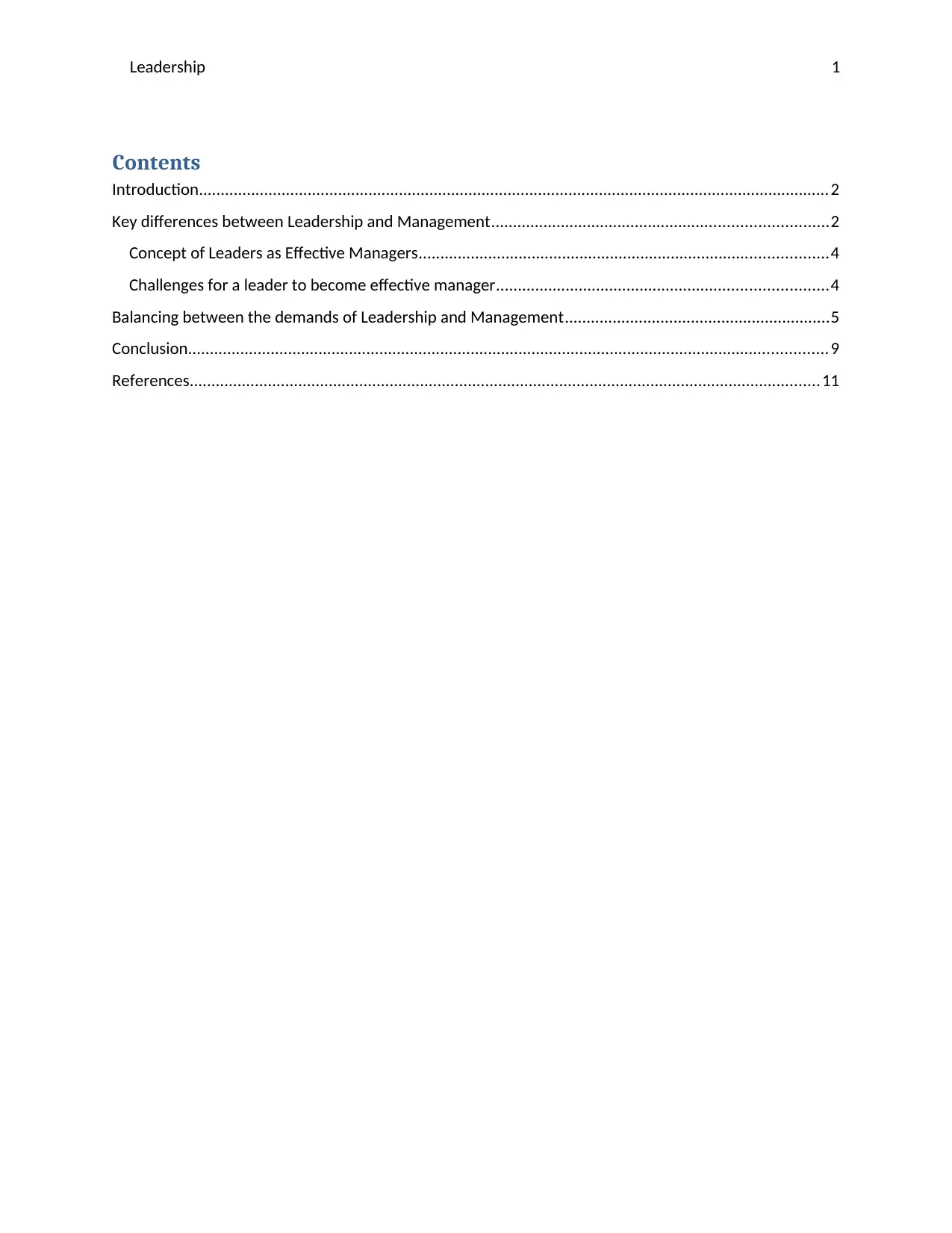
Leadership 1
Contents
Introduction.................................................................................................................................................2
Key differences between Leadership and Management.............................................................................2
Concept of Leaders as Effective Managers..............................................................................................4
Challenges for a leader to become effective manager............................................................................4
Balancing between the demands of Leadership and Management.............................................................5
Conclusion...................................................................................................................................................9
References.................................................................................................................................................11
Contents
Introduction.................................................................................................................................................2
Key differences between Leadership and Management.............................................................................2
Concept of Leaders as Effective Managers..............................................................................................4
Challenges for a leader to become effective manager............................................................................4
Balancing between the demands of Leadership and Management.............................................................5
Conclusion...................................................................................................................................................9
References.................................................................................................................................................11
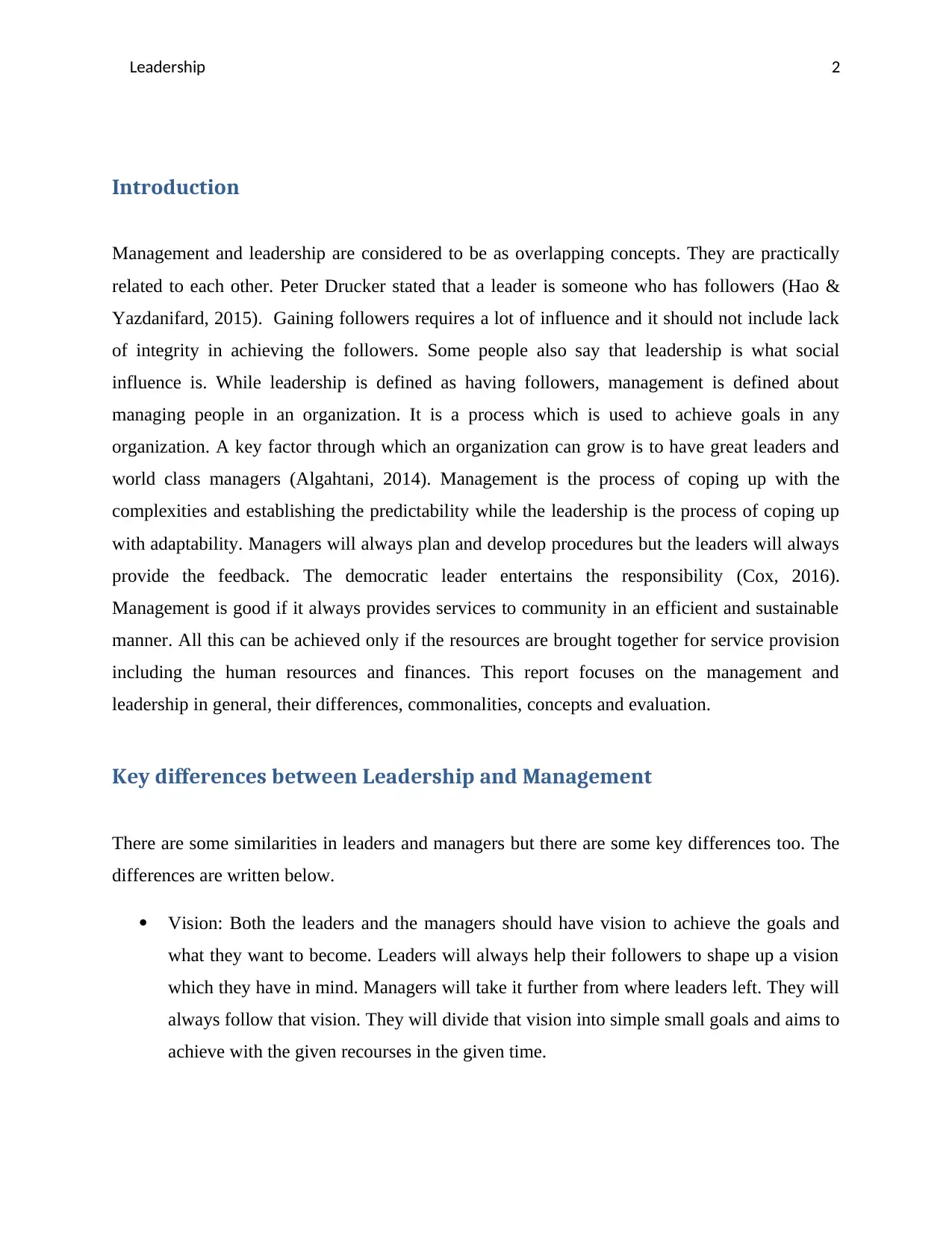
Leadership 2
Introduction
Management and leadership are considered to be as overlapping concepts. They are practically
related to each other. Peter Drucker stated that a leader is someone who has followers (Hao &
Yazdanifard, 2015). Gaining followers requires a lot of influence and it should not include lack
of integrity in achieving the followers. Some people also say that leadership is what social
influence is. While leadership is defined as having followers, management is defined about
managing people in an organization. It is a process which is used to achieve goals in any
organization. A key factor through which an organization can grow is to have great leaders and
world class managers (Algahtani, 2014). Management is the process of coping up with the
complexities and establishing the predictability while the leadership is the process of coping up
with adaptability. Managers will always plan and develop procedures but the leaders will always
provide the feedback. The democratic leader entertains the responsibility (Cox, 2016).
Management is good if it always provides services to community in an efficient and sustainable
manner. All this can be achieved only if the resources are brought together for service provision
including the human resources and finances. This report focuses on the management and
leadership in general, their differences, commonalities, concepts and evaluation.
Key differences between Leadership and Management
There are some similarities in leaders and managers but there are some key differences too. The
differences are written below.
Vision: Both the leaders and the managers should have vision to achieve the goals and
what they want to become. Leaders will always help their followers to shape up a vision
which they have in mind. Managers will take it further from where leaders left. They will
always follow that vision. They will divide that vision into simple small goals and aims to
achieve with the given recourses in the given time.
Introduction
Management and leadership are considered to be as overlapping concepts. They are practically
related to each other. Peter Drucker stated that a leader is someone who has followers (Hao &
Yazdanifard, 2015). Gaining followers requires a lot of influence and it should not include lack
of integrity in achieving the followers. Some people also say that leadership is what social
influence is. While leadership is defined as having followers, management is defined about
managing people in an organization. It is a process which is used to achieve goals in any
organization. A key factor through which an organization can grow is to have great leaders and
world class managers (Algahtani, 2014). Management is the process of coping up with the
complexities and establishing the predictability while the leadership is the process of coping up
with adaptability. Managers will always plan and develop procedures but the leaders will always
provide the feedback. The democratic leader entertains the responsibility (Cox, 2016).
Management is good if it always provides services to community in an efficient and sustainable
manner. All this can be achieved only if the resources are brought together for service provision
including the human resources and finances. This report focuses on the management and
leadership in general, their differences, commonalities, concepts and evaluation.
Key differences between Leadership and Management
There are some similarities in leaders and managers but there are some key differences too. The
differences are written below.
Vision: Both the leaders and the managers should have vision to achieve the goals and
what they want to become. Leaders will always help their followers to shape up a vision
which they have in mind. Managers will take it further from where leaders left. They will
always follow that vision. They will divide that vision into simple small goals and aims to
achieve with the given recourses in the given time.
⊘ This is a preview!⊘
Do you want full access?
Subscribe today to unlock all pages.

Trusted by 1+ million students worldwide
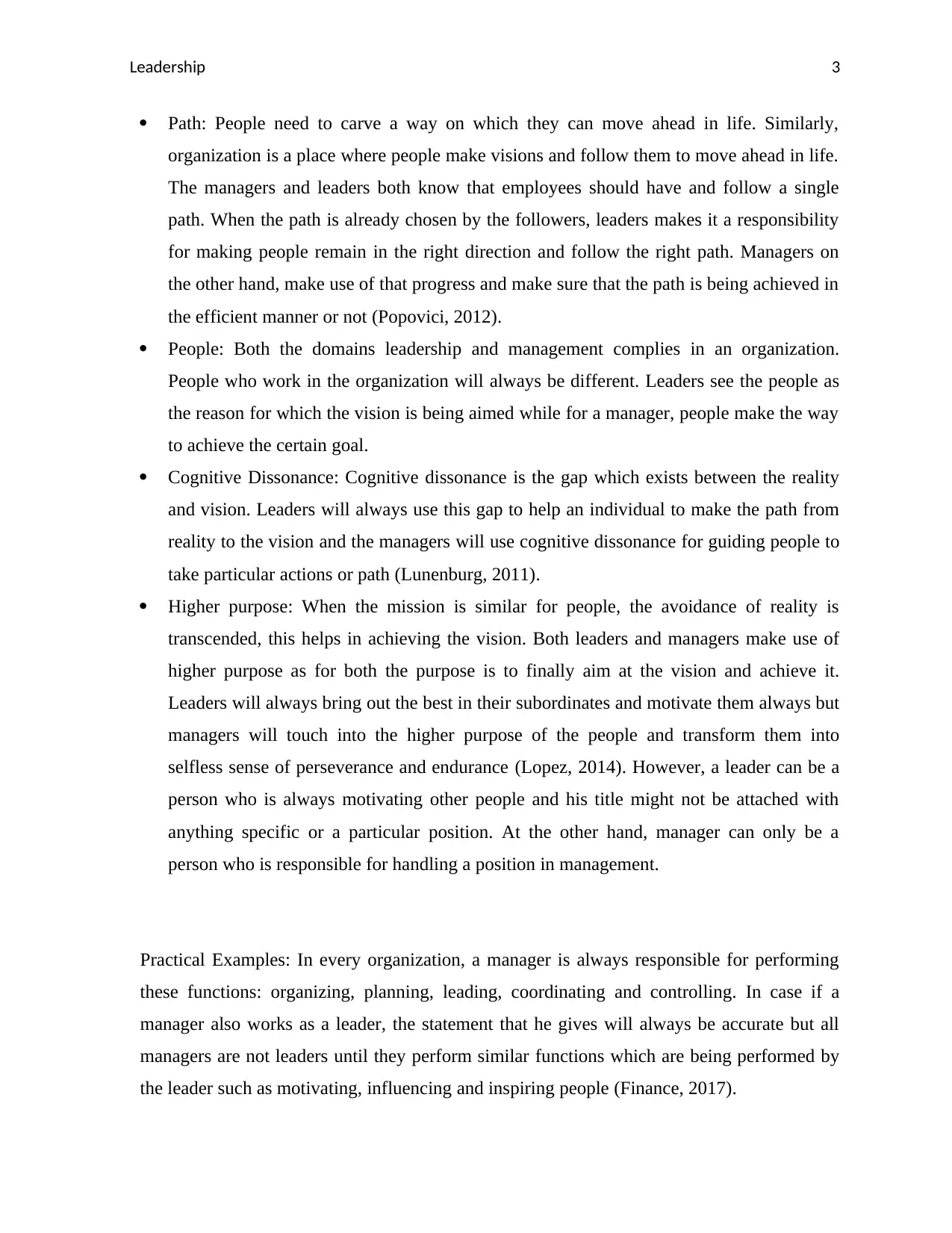
Leadership 3
Path: People need to carve a way on which they can move ahead in life. Similarly,
organization is a place where people make visions and follow them to move ahead in life.
The managers and leaders both know that employees should have and follow a single
path. When the path is already chosen by the followers, leaders makes it a responsibility
for making people remain in the right direction and follow the right path. Managers on
the other hand, make use of that progress and make sure that the path is being achieved in
the efficient manner or not (Popovici, 2012).
People: Both the domains leadership and management complies in an organization.
People who work in the organization will always be different. Leaders see the people as
the reason for which the vision is being aimed while for a manager, people make the way
to achieve the certain goal.
Cognitive Dissonance: Cognitive dissonance is the gap which exists between the reality
and vision. Leaders will always use this gap to help an individual to make the path from
reality to the vision and the managers will use cognitive dissonance for guiding people to
take particular actions or path (Lunenburg, 2011).
Higher purpose: When the mission is similar for people, the avoidance of reality is
transcended, this helps in achieving the vision. Both leaders and managers make use of
higher purpose as for both the purpose is to finally aim at the vision and achieve it.
Leaders will always bring out the best in their subordinates and motivate them always but
managers will touch into the higher purpose of the people and transform them into
selfless sense of perseverance and endurance (Lopez, 2014). However, a leader can be a
person who is always motivating other people and his title might not be attached with
anything specific or a particular position. At the other hand, manager can only be a
person who is responsible for handling a position in management.
Practical Examples: In every organization, a manager is always responsible for performing
these functions: organizing, planning, leading, coordinating and controlling. In case if a
manager also works as a leader, the statement that he gives will always be accurate but all
managers are not leaders until they perform similar functions which are being performed by
the leader such as motivating, influencing and inspiring people (Finance, 2017).
Path: People need to carve a way on which they can move ahead in life. Similarly,
organization is a place where people make visions and follow them to move ahead in life.
The managers and leaders both know that employees should have and follow a single
path. When the path is already chosen by the followers, leaders makes it a responsibility
for making people remain in the right direction and follow the right path. Managers on
the other hand, make use of that progress and make sure that the path is being achieved in
the efficient manner or not (Popovici, 2012).
People: Both the domains leadership and management complies in an organization.
People who work in the organization will always be different. Leaders see the people as
the reason for which the vision is being aimed while for a manager, people make the way
to achieve the certain goal.
Cognitive Dissonance: Cognitive dissonance is the gap which exists between the reality
and vision. Leaders will always use this gap to help an individual to make the path from
reality to the vision and the managers will use cognitive dissonance for guiding people to
take particular actions or path (Lunenburg, 2011).
Higher purpose: When the mission is similar for people, the avoidance of reality is
transcended, this helps in achieving the vision. Both leaders and managers make use of
higher purpose as for both the purpose is to finally aim at the vision and achieve it.
Leaders will always bring out the best in their subordinates and motivate them always but
managers will touch into the higher purpose of the people and transform them into
selfless sense of perseverance and endurance (Lopez, 2014). However, a leader can be a
person who is always motivating other people and his title might not be attached with
anything specific or a particular position. At the other hand, manager can only be a
person who is responsible for handling a position in management.
Practical Examples: In every organization, a manager is always responsible for performing
these functions: organizing, planning, leading, coordinating and controlling. In case if a
manager also works as a leader, the statement that he gives will always be accurate but all
managers are not leaders until they perform similar functions which are being performed by
the leader such as motivating, influencing and inspiring people (Finance, 2017).
Paraphrase This Document
Need a fresh take? Get an instant paraphrase of this document with our AI Paraphraser
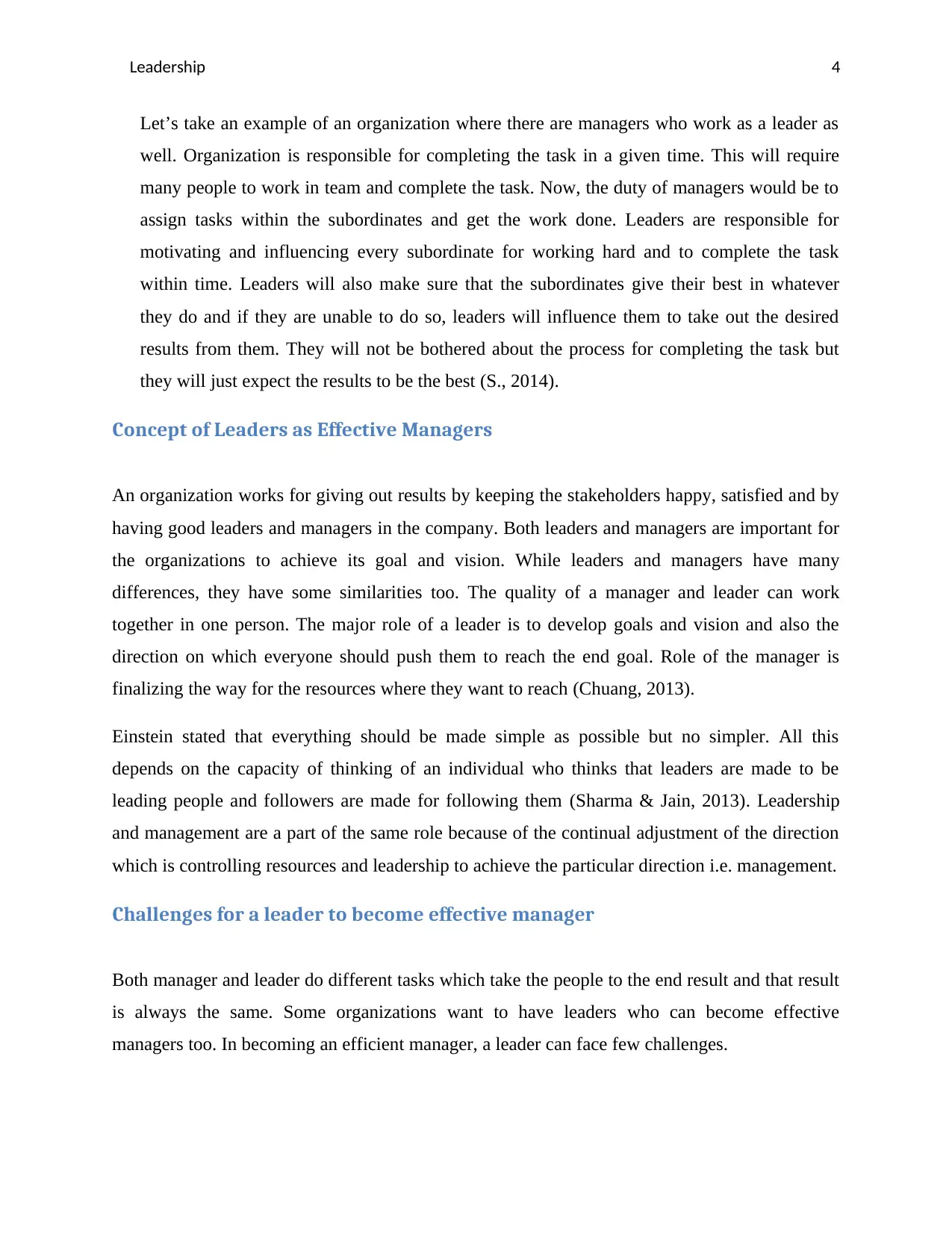
Leadership 4
Let’s take an example of an organization where there are managers who work as a leader as
well. Organization is responsible for completing the task in a given time. This will require
many people to work in team and complete the task. Now, the duty of managers would be to
assign tasks within the subordinates and get the work done. Leaders are responsible for
motivating and influencing every subordinate for working hard and to complete the task
within time. Leaders will also make sure that the subordinates give their best in whatever
they do and if they are unable to do so, leaders will influence them to take out the desired
results from them. They will not be bothered about the process for completing the task but
they will just expect the results to be the best (S., 2014).
Concept of Leaders as Effective Managers
An organization works for giving out results by keeping the stakeholders happy, satisfied and by
having good leaders and managers in the company. Both leaders and managers are important for
the organizations to achieve its goal and vision. While leaders and managers have many
differences, they have some similarities too. The quality of a manager and leader can work
together in one person. The major role of a leader is to develop goals and vision and also the
direction on which everyone should push them to reach the end goal. Role of the manager is
finalizing the way for the resources where they want to reach (Chuang, 2013).
Einstein stated that everything should be made simple as possible but no simpler. All this
depends on the capacity of thinking of an individual who thinks that leaders are made to be
leading people and followers are made for following them (Sharma & Jain, 2013). Leadership
and management are a part of the same role because of the continual adjustment of the direction
which is controlling resources and leadership to achieve the particular direction i.e. management.
Challenges for a leader to become effective manager
Both manager and leader do different tasks which take the people to the end result and that result
is always the same. Some organizations want to have leaders who can become effective
managers too. In becoming an efficient manager, a leader can face few challenges.
Let’s take an example of an organization where there are managers who work as a leader as
well. Organization is responsible for completing the task in a given time. This will require
many people to work in team and complete the task. Now, the duty of managers would be to
assign tasks within the subordinates and get the work done. Leaders are responsible for
motivating and influencing every subordinate for working hard and to complete the task
within time. Leaders will also make sure that the subordinates give their best in whatever
they do and if they are unable to do so, leaders will influence them to take out the desired
results from them. They will not be bothered about the process for completing the task but
they will just expect the results to be the best (S., 2014).
Concept of Leaders as Effective Managers
An organization works for giving out results by keeping the stakeholders happy, satisfied and by
having good leaders and managers in the company. Both leaders and managers are important for
the organizations to achieve its goal and vision. While leaders and managers have many
differences, they have some similarities too. The quality of a manager and leader can work
together in one person. The major role of a leader is to develop goals and vision and also the
direction on which everyone should push them to reach the end goal. Role of the manager is
finalizing the way for the resources where they want to reach (Chuang, 2013).
Einstein stated that everything should be made simple as possible but no simpler. All this
depends on the capacity of thinking of an individual who thinks that leaders are made to be
leading people and followers are made for following them (Sharma & Jain, 2013). Leadership
and management are a part of the same role because of the continual adjustment of the direction
which is controlling resources and leadership to achieve the particular direction i.e. management.
Challenges for a leader to become effective manager
Both manager and leader do different tasks which take the people to the end result and that result
is always the same. Some organizations want to have leaders who can become effective
managers too. In becoming an efficient manager, a leader can face few challenges.
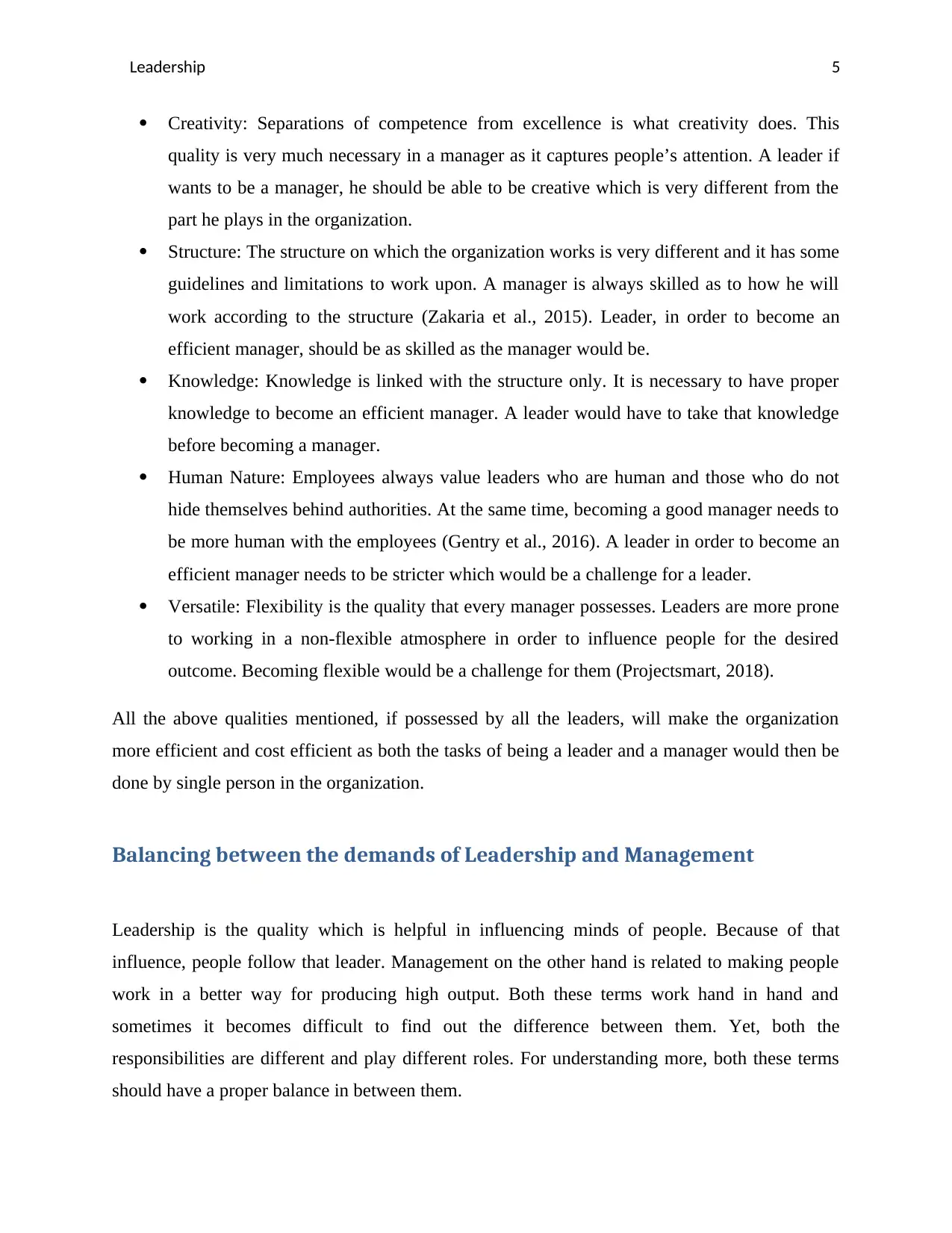
Leadership 5
Creativity: Separations of competence from excellence is what creativity does. This
quality is very much necessary in a manager as it captures people’s attention. A leader if
wants to be a manager, he should be able to be creative which is very different from the
part he plays in the organization.
Structure: The structure on which the organization works is very different and it has some
guidelines and limitations to work upon. A manager is always skilled as to how he will
work according to the structure (Zakaria et al., 2015). Leader, in order to become an
efficient manager, should be as skilled as the manager would be.
Knowledge: Knowledge is linked with the structure only. It is necessary to have proper
knowledge to become an efficient manager. A leader would have to take that knowledge
before becoming a manager.
Human Nature: Employees always value leaders who are human and those who do not
hide themselves behind authorities. At the same time, becoming a good manager needs to
be more human with the employees (Gentry et al., 2016). A leader in order to become an
efficient manager needs to be stricter which would be a challenge for a leader.
Versatile: Flexibility is the quality that every manager possesses. Leaders are more prone
to working in a non-flexible atmosphere in order to influence people for the desired
outcome. Becoming flexible would be a challenge for them (Projectsmart, 2018).
All the above qualities mentioned, if possessed by all the leaders, will make the organization
more efficient and cost efficient as both the tasks of being a leader and a manager would then be
done by single person in the organization.
Balancing between the demands of Leadership and Management
Leadership is the quality which is helpful in influencing minds of people. Because of that
influence, people follow that leader. Management on the other hand is related to making people
work in a better way for producing high output. Both these terms work hand in hand and
sometimes it becomes difficult to find out the difference between them. Yet, both the
responsibilities are different and play different roles. For understanding more, both these terms
should have a proper balance in between them.
Creativity: Separations of competence from excellence is what creativity does. This
quality is very much necessary in a manager as it captures people’s attention. A leader if
wants to be a manager, he should be able to be creative which is very different from the
part he plays in the organization.
Structure: The structure on which the organization works is very different and it has some
guidelines and limitations to work upon. A manager is always skilled as to how he will
work according to the structure (Zakaria et al., 2015). Leader, in order to become an
efficient manager, should be as skilled as the manager would be.
Knowledge: Knowledge is linked with the structure only. It is necessary to have proper
knowledge to become an efficient manager. A leader would have to take that knowledge
before becoming a manager.
Human Nature: Employees always value leaders who are human and those who do not
hide themselves behind authorities. At the same time, becoming a good manager needs to
be more human with the employees (Gentry et al., 2016). A leader in order to become an
efficient manager needs to be stricter which would be a challenge for a leader.
Versatile: Flexibility is the quality that every manager possesses. Leaders are more prone
to working in a non-flexible atmosphere in order to influence people for the desired
outcome. Becoming flexible would be a challenge for them (Projectsmart, 2018).
All the above qualities mentioned, if possessed by all the leaders, will make the organization
more efficient and cost efficient as both the tasks of being a leader and a manager would then be
done by single person in the organization.
Balancing between the demands of Leadership and Management
Leadership is the quality which is helpful in influencing minds of people. Because of that
influence, people follow that leader. Management on the other hand is related to making people
work in a better way for producing high output. Both these terms work hand in hand and
sometimes it becomes difficult to find out the difference between them. Yet, both the
responsibilities are different and play different roles. For understanding more, both these terms
should have a proper balance in between them.
⊘ This is a preview!⊘
Do you want full access?
Subscribe today to unlock all pages.

Trusted by 1+ million students worldwide
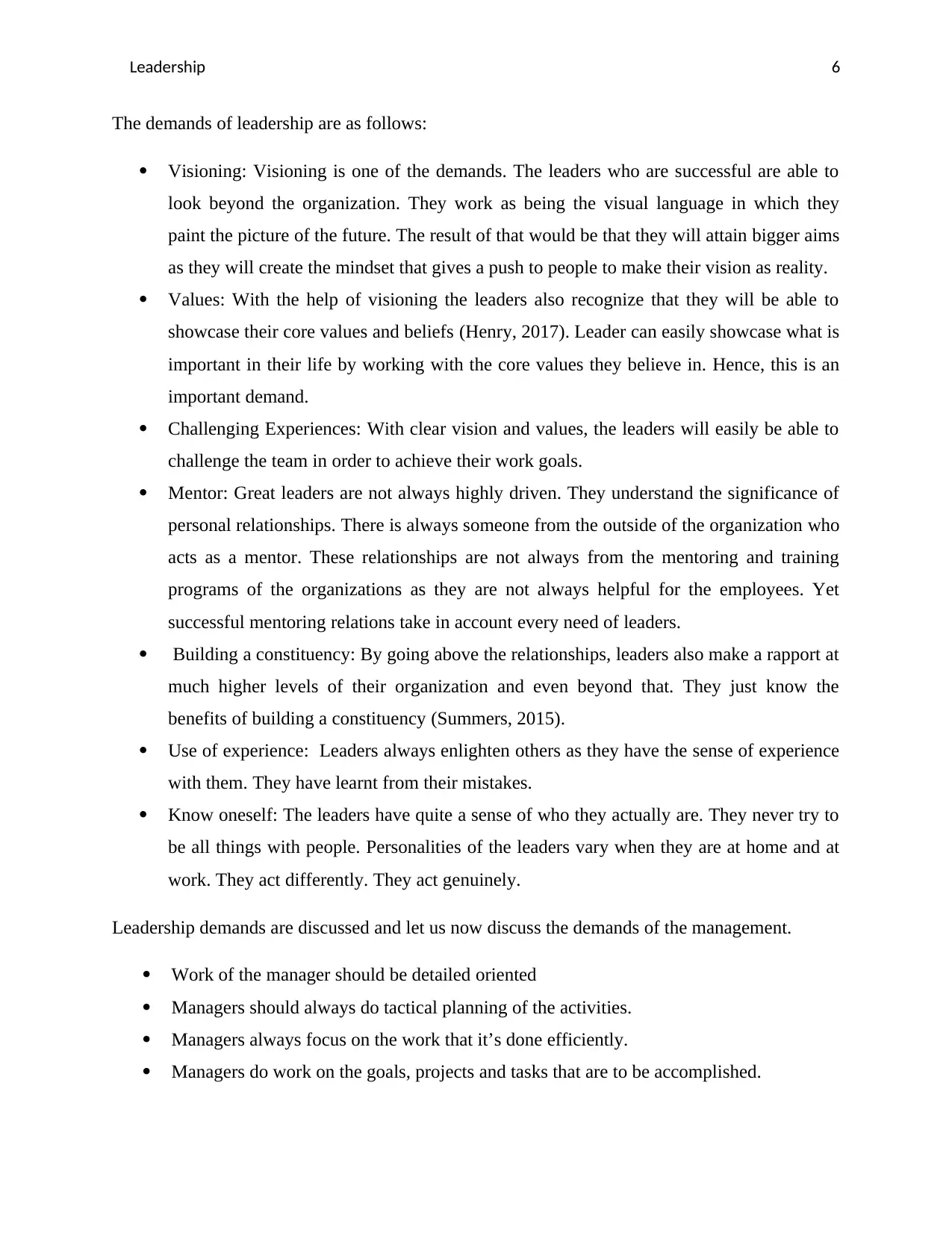
Leadership 6
The demands of leadership are as follows:
Visioning: Visioning is one of the demands. The leaders who are successful are able to
look beyond the organization. They work as being the visual language in which they
paint the picture of the future. The result of that would be that they will attain bigger aims
as they will create the mindset that gives a push to people to make their vision as reality.
Values: With the help of visioning the leaders also recognize that they will be able to
showcase their core values and beliefs (Henry, 2017). Leader can easily showcase what is
important in their life by working with the core values they believe in. Hence, this is an
important demand.
Challenging Experiences: With clear vision and values, the leaders will easily be able to
challenge the team in order to achieve their work goals.
Mentor: Great leaders are not always highly driven. They understand the significance of
personal relationships. There is always someone from the outside of the organization who
acts as a mentor. These relationships are not always from the mentoring and training
programs of the organizations as they are not always helpful for the employees. Yet
successful mentoring relations take in account every need of leaders.
Building a constituency: By going above the relationships, leaders also make a rapport at
much higher levels of their organization and even beyond that. They just know the
benefits of building a constituency (Summers, 2015).
Use of experience: Leaders always enlighten others as they have the sense of experience
with them. They have learnt from their mistakes.
Know oneself: The leaders have quite a sense of who they actually are. They never try to
be all things with people. Personalities of the leaders vary when they are at home and at
work. They act differently. They act genuinely.
Leadership demands are discussed and let us now discuss the demands of the management.
Work of the manager should be detailed oriented
Managers should always do tactical planning of the activities.
Managers always focus on the work that it’s done efficiently.
Managers do work on the goals, projects and tasks that are to be accomplished.
The demands of leadership are as follows:
Visioning: Visioning is one of the demands. The leaders who are successful are able to
look beyond the organization. They work as being the visual language in which they
paint the picture of the future. The result of that would be that they will attain bigger aims
as they will create the mindset that gives a push to people to make their vision as reality.
Values: With the help of visioning the leaders also recognize that they will be able to
showcase their core values and beliefs (Henry, 2017). Leader can easily showcase what is
important in their life by working with the core values they believe in. Hence, this is an
important demand.
Challenging Experiences: With clear vision and values, the leaders will easily be able to
challenge the team in order to achieve their work goals.
Mentor: Great leaders are not always highly driven. They understand the significance of
personal relationships. There is always someone from the outside of the organization who
acts as a mentor. These relationships are not always from the mentoring and training
programs of the organizations as they are not always helpful for the employees. Yet
successful mentoring relations take in account every need of leaders.
Building a constituency: By going above the relationships, leaders also make a rapport at
much higher levels of their organization and even beyond that. They just know the
benefits of building a constituency (Summers, 2015).
Use of experience: Leaders always enlighten others as they have the sense of experience
with them. They have learnt from their mistakes.
Know oneself: The leaders have quite a sense of who they actually are. They never try to
be all things with people. Personalities of the leaders vary when they are at home and at
work. They act differently. They act genuinely.
Leadership demands are discussed and let us now discuss the demands of the management.
Work of the manager should be detailed oriented
Managers should always do tactical planning of the activities.
Managers always focus on the work that it’s done efficiently.
Managers do work on the goals, projects and tasks that are to be accomplished.
Paraphrase This Document
Need a fresh take? Get an instant paraphrase of this document with our AI Paraphraser
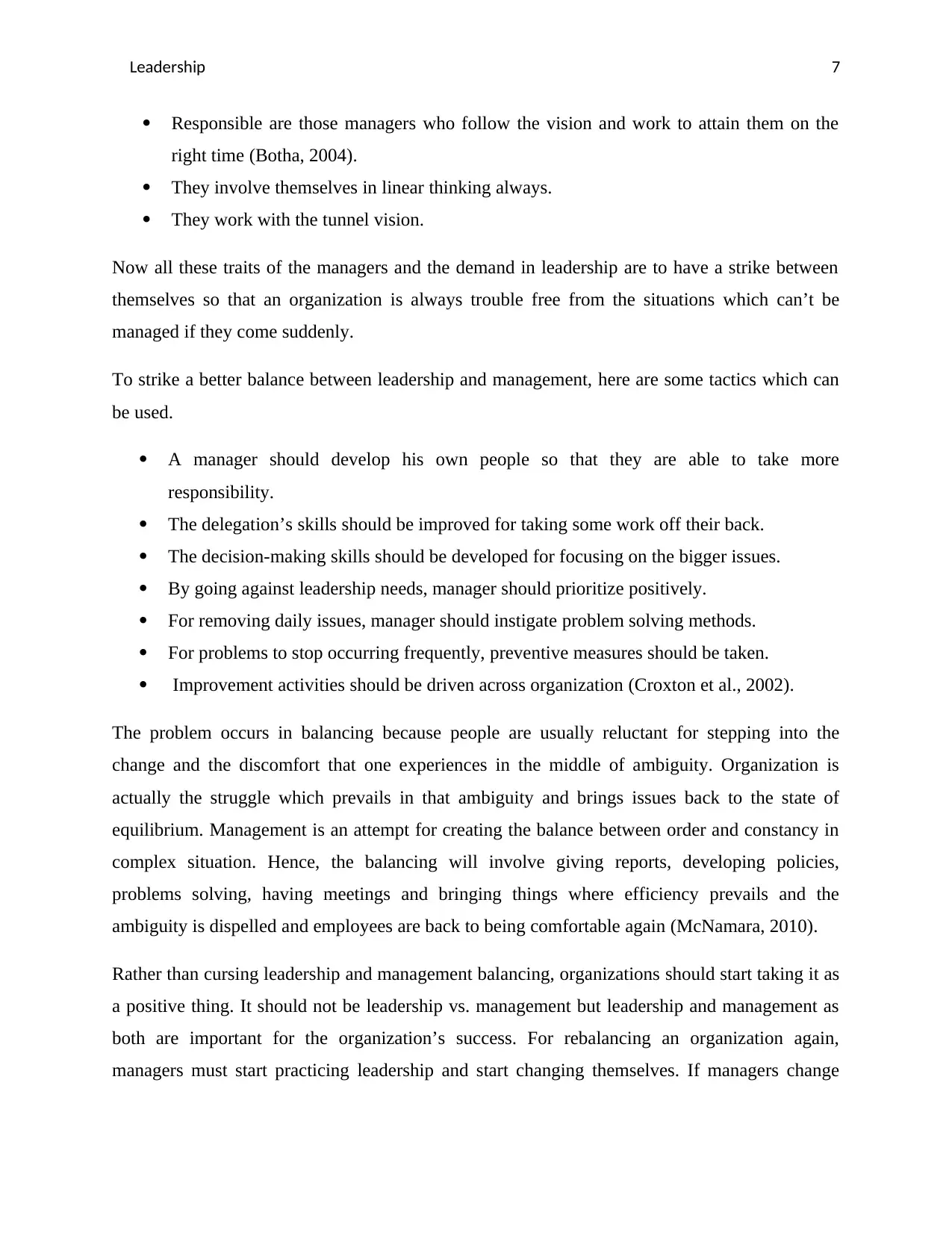
Leadership 7
Responsible are those managers who follow the vision and work to attain them on the
right time (Botha, 2004).
They involve themselves in linear thinking always.
They work with the tunnel vision.
Now all these traits of the managers and the demand in leadership are to have a strike between
themselves so that an organization is always trouble free from the situations which can’t be
managed if they come suddenly.
To strike a better balance between leadership and management, here are some tactics which can
be used.
A manager should develop his own people so that they are able to take more
responsibility.
The delegation’s skills should be improved for taking some work off their back.
The decision-making skills should be developed for focusing on the bigger issues.
By going against leadership needs, manager should prioritize positively.
For removing daily issues, manager should instigate problem solving methods.
For problems to stop occurring frequently, preventive measures should be taken.
Improvement activities should be driven across organization (Croxton et al., 2002).
The problem occurs in balancing because people are usually reluctant for stepping into the
change and the discomfort that one experiences in the middle of ambiguity. Organization is
actually the struggle which prevails in that ambiguity and brings issues back to the state of
equilibrium. Management is an attempt for creating the balance between order and constancy in
complex situation. Hence, the balancing will involve giving reports, developing policies,
problems solving, having meetings and bringing things where efficiency prevails and the
ambiguity is dispelled and employees are back to being comfortable again (McNamara, 2010).
Rather than cursing leadership and management balancing, organizations should start taking it as
a positive thing. It should not be leadership vs. management but leadership and management as
both are important for the organization’s success. For rebalancing an organization again,
managers must start practicing leadership and start changing themselves. If managers change
Responsible are those managers who follow the vision and work to attain them on the
right time (Botha, 2004).
They involve themselves in linear thinking always.
They work with the tunnel vision.
Now all these traits of the managers and the demand in leadership are to have a strike between
themselves so that an organization is always trouble free from the situations which can’t be
managed if they come suddenly.
To strike a better balance between leadership and management, here are some tactics which can
be used.
A manager should develop his own people so that they are able to take more
responsibility.
The delegation’s skills should be improved for taking some work off their back.
The decision-making skills should be developed for focusing on the bigger issues.
By going against leadership needs, manager should prioritize positively.
For removing daily issues, manager should instigate problem solving methods.
For problems to stop occurring frequently, preventive measures should be taken.
Improvement activities should be driven across organization (Croxton et al., 2002).
The problem occurs in balancing because people are usually reluctant for stepping into the
change and the discomfort that one experiences in the middle of ambiguity. Organization is
actually the struggle which prevails in that ambiguity and brings issues back to the state of
equilibrium. Management is an attempt for creating the balance between order and constancy in
complex situation. Hence, the balancing will involve giving reports, developing policies,
problems solving, having meetings and bringing things where efficiency prevails and the
ambiguity is dispelled and employees are back to being comfortable again (McNamara, 2010).
Rather than cursing leadership and management balancing, organizations should start taking it as
a positive thing. It should not be leadership vs. management but leadership and management as
both are important for the organization’s success. For rebalancing an organization again,
managers must start practicing leadership and start changing themselves. If managers change
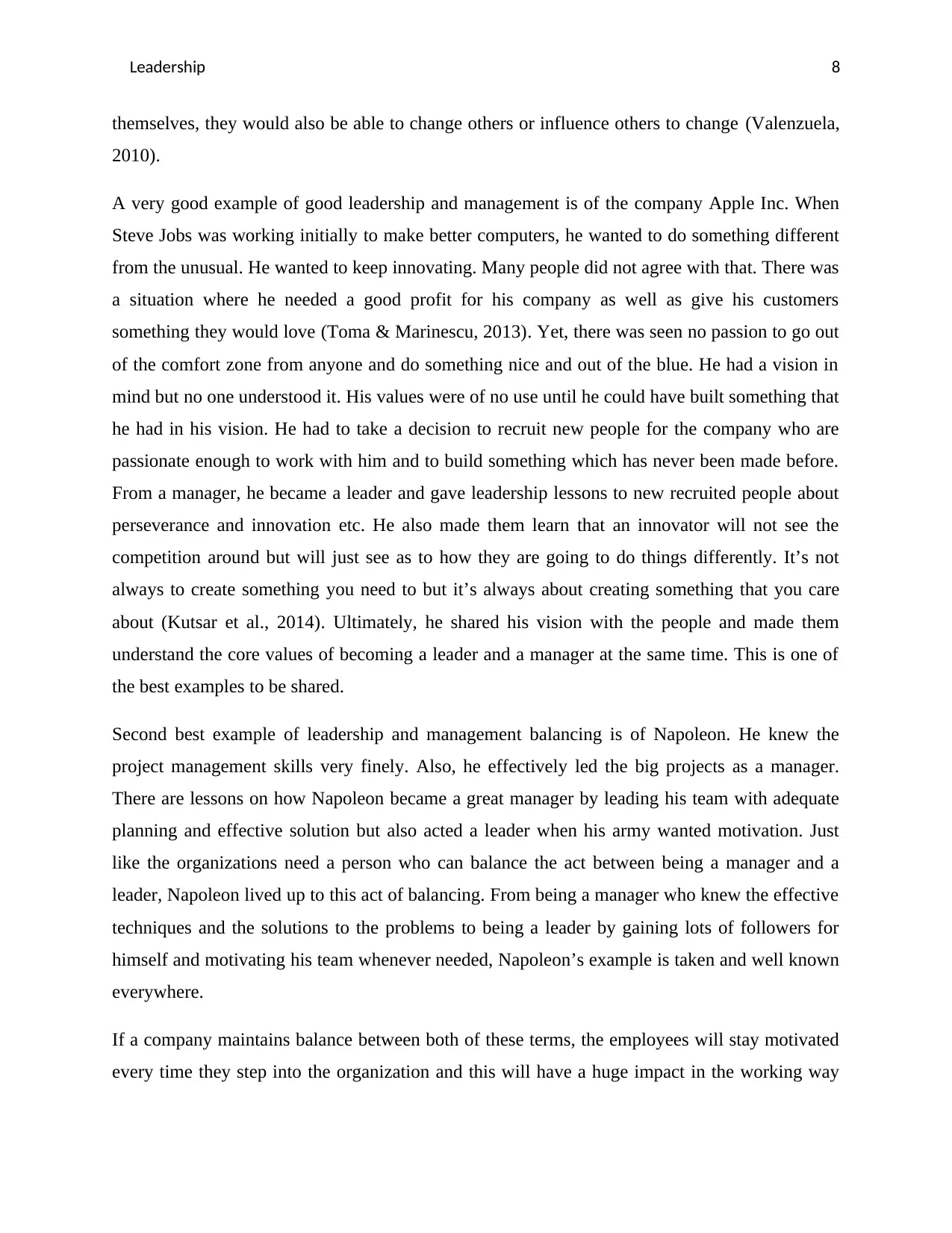
Leadership 8
themselves, they would also be able to change others or influence others to change (Valenzuela,
2010).
A very good example of good leadership and management is of the company Apple Inc. When
Steve Jobs was working initially to make better computers, he wanted to do something different
from the unusual. He wanted to keep innovating. Many people did not agree with that. There was
a situation where he needed a good profit for his company as well as give his customers
something they would love (Toma & Marinescu, 2013). Yet, there was seen no passion to go out
of the comfort zone from anyone and do something nice and out of the blue. He had a vision in
mind but no one understood it. His values were of no use until he could have built something that
he had in his vision. He had to take a decision to recruit new people for the company who are
passionate enough to work with him and to build something which has never been made before.
From a manager, he became a leader and gave leadership lessons to new recruited people about
perseverance and innovation etc. He also made them learn that an innovator will not see the
competition around but will just see as to how they are going to do things differently. It’s not
always to create something you need to but it’s always about creating something that you care
about (Kutsar et al., 2014). Ultimately, he shared his vision with the people and made them
understand the core values of becoming a leader and a manager at the same time. This is one of
the best examples to be shared.
Second best example of leadership and management balancing is of Napoleon. He knew the
project management skills very finely. Also, he effectively led the big projects as a manager.
There are lessons on how Napoleon became a great manager by leading his team with adequate
planning and effective solution but also acted a leader when his army wanted motivation. Just
like the organizations need a person who can balance the act between being a manager and a
leader, Napoleon lived up to this act of balancing. From being a manager who knew the effective
techniques and the solutions to the problems to being a leader by gaining lots of followers for
himself and motivating his team whenever needed, Napoleon’s example is taken and well known
everywhere.
If a company maintains balance between both of these terms, the employees will stay motivated
every time they step into the organization and this will have a huge impact in the working way
themselves, they would also be able to change others or influence others to change (Valenzuela,
2010).
A very good example of good leadership and management is of the company Apple Inc. When
Steve Jobs was working initially to make better computers, he wanted to do something different
from the unusual. He wanted to keep innovating. Many people did not agree with that. There was
a situation where he needed a good profit for his company as well as give his customers
something they would love (Toma & Marinescu, 2013). Yet, there was seen no passion to go out
of the comfort zone from anyone and do something nice and out of the blue. He had a vision in
mind but no one understood it. His values were of no use until he could have built something that
he had in his vision. He had to take a decision to recruit new people for the company who are
passionate enough to work with him and to build something which has never been made before.
From a manager, he became a leader and gave leadership lessons to new recruited people about
perseverance and innovation etc. He also made them learn that an innovator will not see the
competition around but will just see as to how they are going to do things differently. It’s not
always to create something you need to but it’s always about creating something that you care
about (Kutsar et al., 2014). Ultimately, he shared his vision with the people and made them
understand the core values of becoming a leader and a manager at the same time. This is one of
the best examples to be shared.
Second best example of leadership and management balancing is of Napoleon. He knew the
project management skills very finely. Also, he effectively led the big projects as a manager.
There are lessons on how Napoleon became a great manager by leading his team with adequate
planning and effective solution but also acted a leader when his army wanted motivation. Just
like the organizations need a person who can balance the act between being a manager and a
leader, Napoleon lived up to this act of balancing. From being a manager who knew the effective
techniques and the solutions to the problems to being a leader by gaining lots of followers for
himself and motivating his team whenever needed, Napoleon’s example is taken and well known
everywhere.
If a company maintains balance between both of these terms, the employees will stay motivated
every time they step into the organization and this will have a huge impact in the working way
⊘ This is a preview!⊘
Do you want full access?
Subscribe today to unlock all pages.

Trusted by 1+ million students worldwide
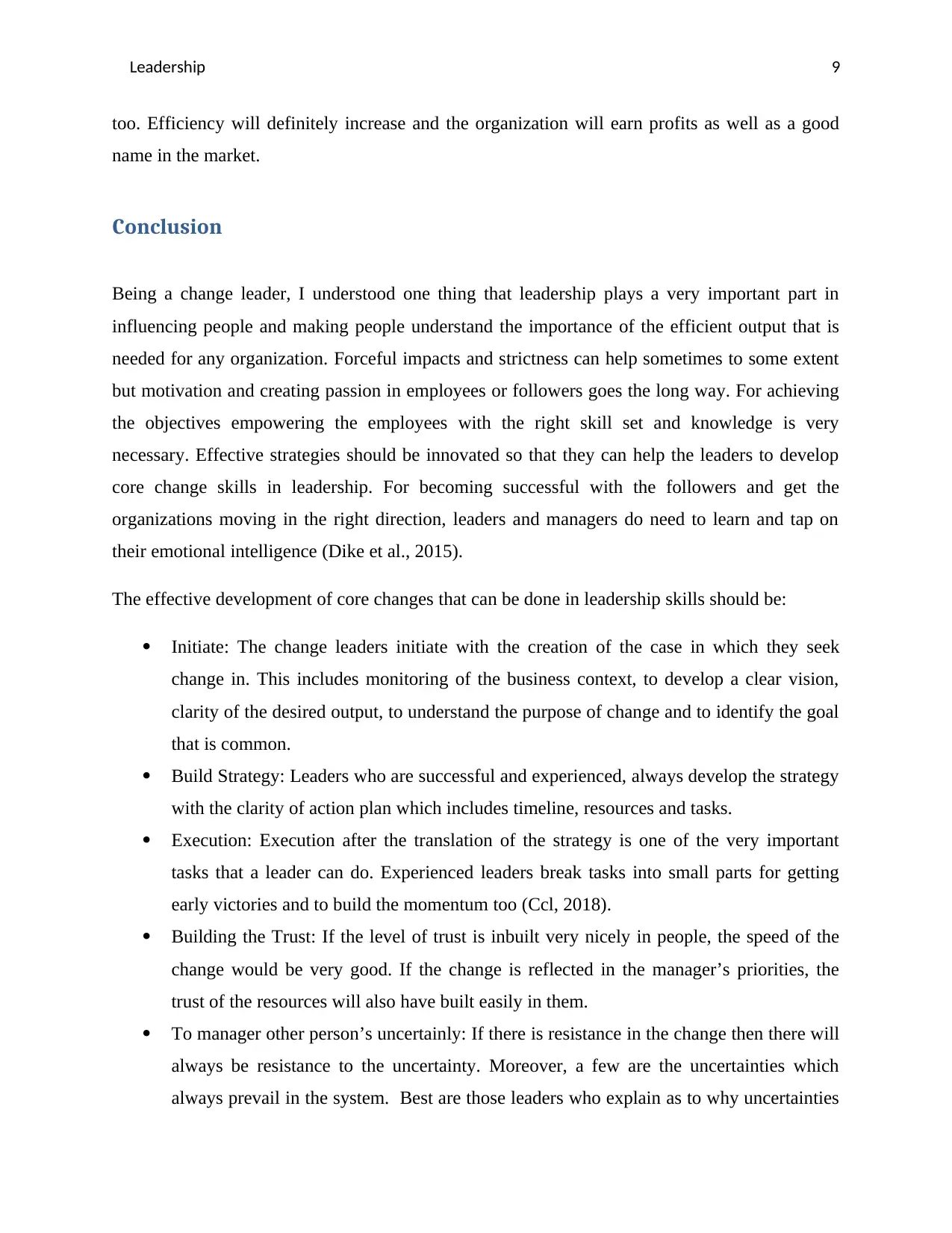
Leadership 9
too. Efficiency will definitely increase and the organization will earn profits as well as a good
name in the market.
Conclusion
Being a change leader, I understood one thing that leadership plays a very important part in
influencing people and making people understand the importance of the efficient output that is
needed for any organization. Forceful impacts and strictness can help sometimes to some extent
but motivation and creating passion in employees or followers goes the long way. For achieving
the objectives empowering the employees with the right skill set and knowledge is very
necessary. Effective strategies should be innovated so that they can help the leaders to develop
core change skills in leadership. For becoming successful with the followers and get the
organizations moving in the right direction, leaders and managers do need to learn and tap on
their emotional intelligence (Dike et al., 2015).
The effective development of core changes that can be done in leadership skills should be:
Initiate: The change leaders initiate with the creation of the case in which they seek
change in. This includes monitoring of the business context, to develop a clear vision,
clarity of the desired output, to understand the purpose of change and to identify the goal
that is common.
Build Strategy: Leaders who are successful and experienced, always develop the strategy
with the clarity of action plan which includes timeline, resources and tasks.
Execution: Execution after the translation of the strategy is one of the very important
tasks that a leader can do. Experienced leaders break tasks into small parts for getting
early victories and to build the momentum too (Ccl, 2018).
Building the Trust: If the level of trust is inbuilt very nicely in people, the speed of the
change would be very good. If the change is reflected in the manager’s priorities, the
trust of the resources will also have built easily in them.
To manager other person’s uncertainly: If there is resistance in the change then there will
always be resistance to the uncertainty. Moreover, a few are the uncertainties which
always prevail in the system. Best are those leaders who explain as to why uncertainties
too. Efficiency will definitely increase and the organization will earn profits as well as a good
name in the market.
Conclusion
Being a change leader, I understood one thing that leadership plays a very important part in
influencing people and making people understand the importance of the efficient output that is
needed for any organization. Forceful impacts and strictness can help sometimes to some extent
but motivation and creating passion in employees or followers goes the long way. For achieving
the objectives empowering the employees with the right skill set and knowledge is very
necessary. Effective strategies should be innovated so that they can help the leaders to develop
core change skills in leadership. For becoming successful with the followers and get the
organizations moving in the right direction, leaders and managers do need to learn and tap on
their emotional intelligence (Dike et al., 2015).
The effective development of core changes that can be done in leadership skills should be:
Initiate: The change leaders initiate with the creation of the case in which they seek
change in. This includes monitoring of the business context, to develop a clear vision,
clarity of the desired output, to understand the purpose of change and to identify the goal
that is common.
Build Strategy: Leaders who are successful and experienced, always develop the strategy
with the clarity of action plan which includes timeline, resources and tasks.
Execution: Execution after the translation of the strategy is one of the very important
tasks that a leader can do. Experienced leaders break tasks into small parts for getting
early victories and to build the momentum too (Ccl, 2018).
Building the Trust: If the level of trust is inbuilt very nicely in people, the speed of the
change would be very good. If the change is reflected in the manager’s priorities, the
trust of the resources will also have built easily in them.
To manager other person’s uncertainly: If there is resistance in the change then there will
always be resistance to the uncertainty. Moreover, a few are the uncertainties which
always prevail in the system. Best are those leaders who explain as to why uncertainties
Paraphrase This Document
Need a fresh take? Get an instant paraphrase of this document with our AI Paraphraser
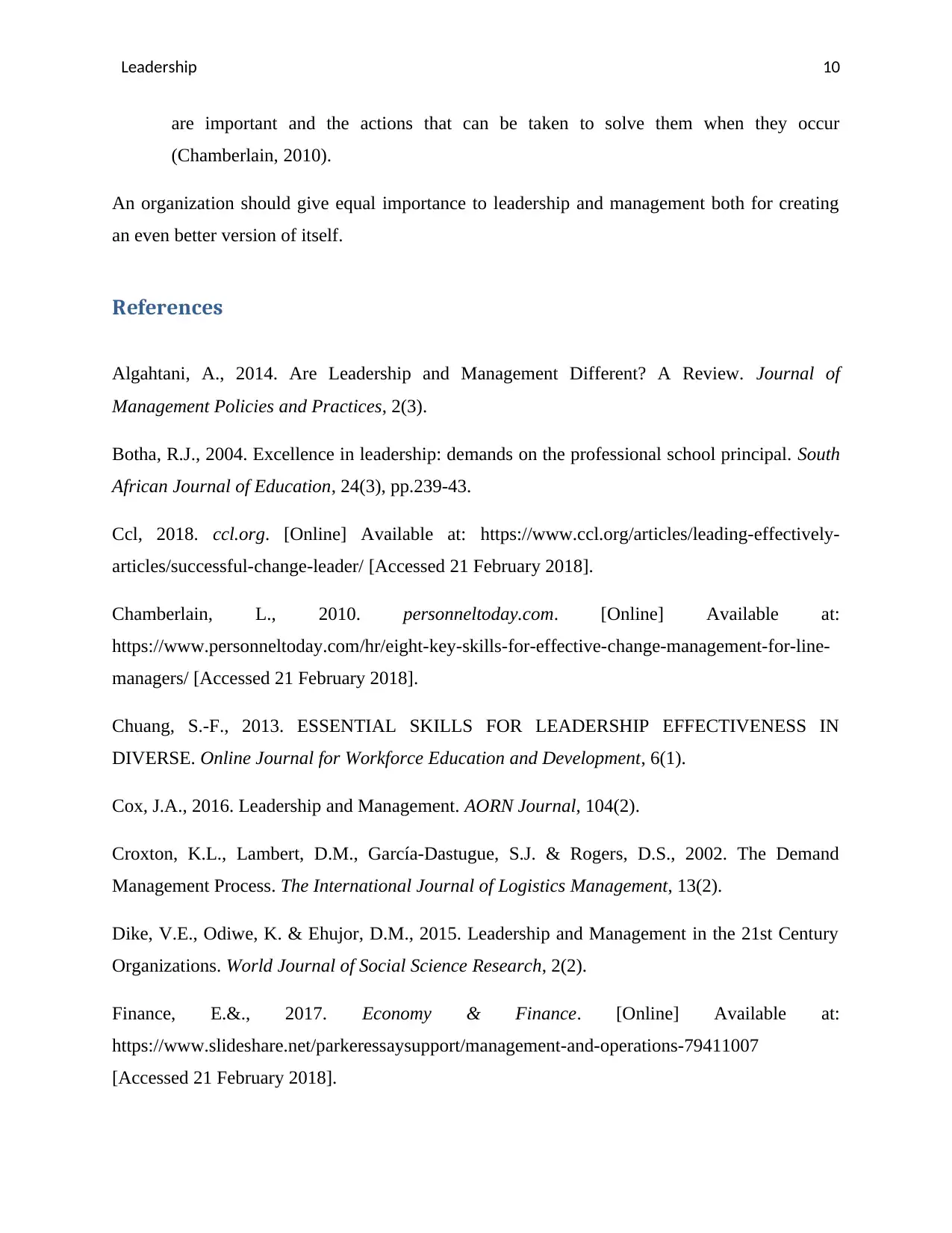
Leadership 10
are important and the actions that can be taken to solve them when they occur
(Chamberlain, 2010).
An organization should give equal importance to leadership and management both for creating
an even better version of itself.
References
Algahtani, A., 2014. Are Leadership and Management Different? A Review. Journal of
Management Policies and Practices, 2(3).
Botha, R.J., 2004. Excellence in leadership: demands on the professional school principal. South
African Journal of Education, 24(3), pp.239-43.
Ccl, 2018. ccl.org. [Online] Available at: https://www.ccl.org/articles/leading-effectively-
articles/successful-change-leader/ [Accessed 21 February 2018].
Chamberlain, L., 2010. personneltoday.com. [Online] Available at:
https://www.personneltoday.com/hr/eight-key-skills-for-effective-change-management-for-line-
managers/ [Accessed 21 February 2018].
Chuang, S.-F., 2013. ESSENTIAL SKILLS FOR LEADERSHIP EFFECTIVENESS IN
DIVERSE. Online Journal for Workforce Education and Development, 6(1).
Cox, J.A., 2016. Leadership and Management. AORN Journal, 104(2).
Croxton, K.L., Lambert, D.M., García-Dastugue, S.J. & Rogers, D.S., 2002. The Demand
Management Process. The International Journal of Logistics Management, 13(2).
Dike, V.E., Odiwe, K. & Ehujor, D.M., 2015. Leadership and Management in the 21st Century
Organizations. World Journal of Social Science Research, 2(2).
Finance, E.&., 2017. Economy & Finance. [Online] Available at:
https://www.slideshare.net/parkeressaysupport/management-and-operations-79411007
[Accessed 21 February 2018].
are important and the actions that can be taken to solve them when they occur
(Chamberlain, 2010).
An organization should give equal importance to leadership and management both for creating
an even better version of itself.
References
Algahtani, A., 2014. Are Leadership and Management Different? A Review. Journal of
Management Policies and Practices, 2(3).
Botha, R.J., 2004. Excellence in leadership: demands on the professional school principal. South
African Journal of Education, 24(3), pp.239-43.
Ccl, 2018. ccl.org. [Online] Available at: https://www.ccl.org/articles/leading-effectively-
articles/successful-change-leader/ [Accessed 21 February 2018].
Chamberlain, L., 2010. personneltoday.com. [Online] Available at:
https://www.personneltoday.com/hr/eight-key-skills-for-effective-change-management-for-line-
managers/ [Accessed 21 February 2018].
Chuang, S.-F., 2013. ESSENTIAL SKILLS FOR LEADERSHIP EFFECTIVENESS IN
DIVERSE. Online Journal for Workforce Education and Development, 6(1).
Cox, J.A., 2016. Leadership and Management. AORN Journal, 104(2).
Croxton, K.L., Lambert, D.M., García-Dastugue, S.J. & Rogers, D.S., 2002. The Demand
Management Process. The International Journal of Logistics Management, 13(2).
Dike, V.E., Odiwe, K. & Ehujor, D.M., 2015. Leadership and Management in the 21st Century
Organizations. World Journal of Social Science Research, 2(2).
Finance, E.&., 2017. Economy & Finance. [Online] Available at:
https://www.slideshare.net/parkeressaysupport/management-and-operations-79411007
[Accessed 21 February 2018].
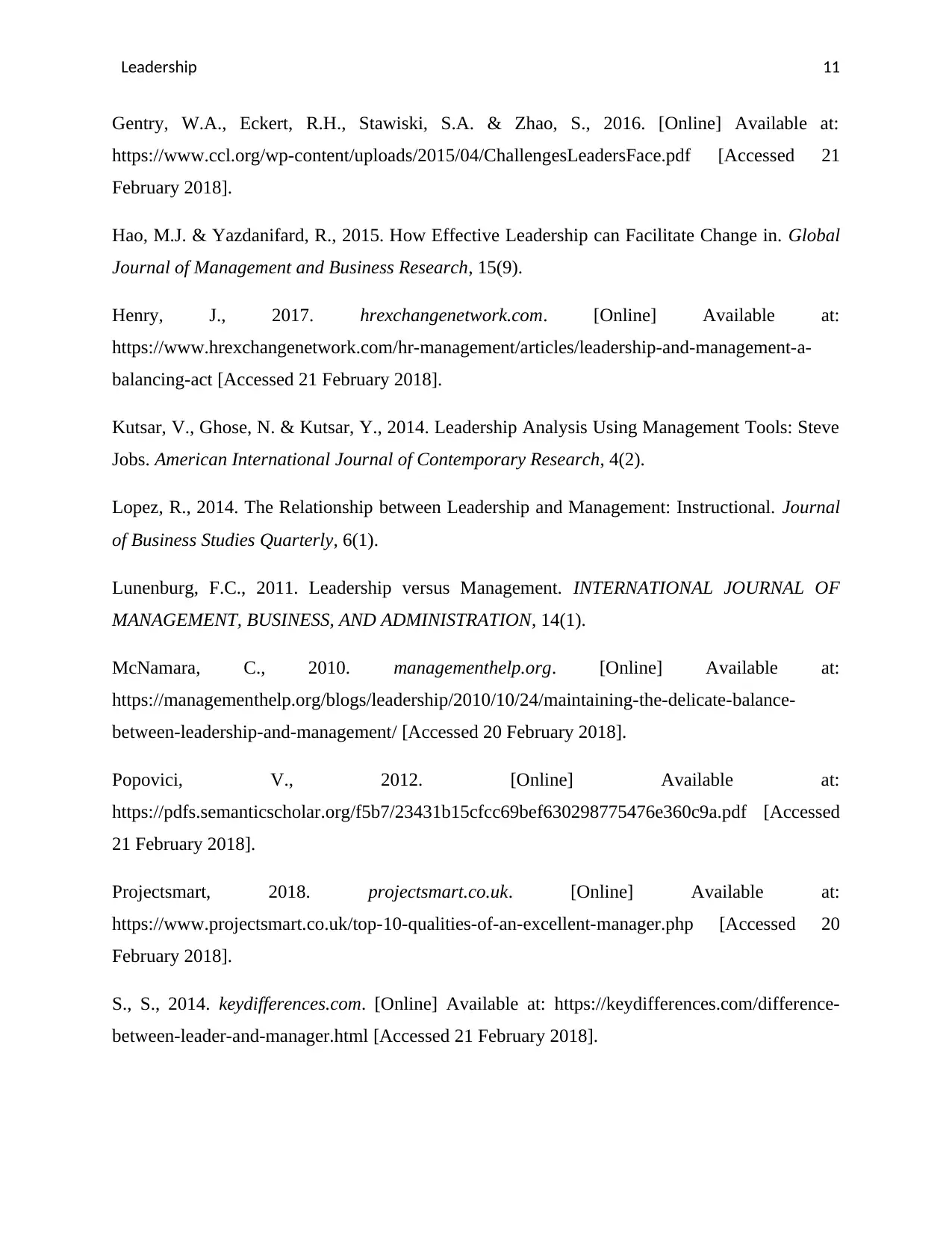
Leadership 11
Gentry, W.A., Eckert, R.H., Stawiski, S.A. & Zhao, S., 2016. [Online] Available at:
https://www.ccl.org/wp-content/uploads/2015/04/ChallengesLeadersFace.pdf [Accessed 21
February 2018].
Hao, M.J. & Yazdanifard, R., 2015. How Effective Leadership can Facilitate Change in. Global
Journal of Management and Business Research, 15(9).
Henry, J., 2017. hrexchangenetwork.com. [Online] Available at:
https://www.hrexchangenetwork.com/hr-management/articles/leadership-and-management-a-
balancing-act [Accessed 21 February 2018].
Kutsar, V., Ghose, N. & Kutsar, Y., 2014. Leadership Analysis Using Management Tools: Steve
Jobs. American International Journal of Contemporary Research, 4(2).
Lopez, R., 2014. The Relationship between Leadership and Management: Instructional. Journal
of Business Studies Quarterly, 6(1).
Lunenburg, F.C., 2011. Leadership versus Management. INTERNATIONAL JOURNAL OF
MANAGEMENT, BUSINESS, AND ADMINISTRATION, 14(1).
McNamara, C., 2010. managementhelp.org. [Online] Available at:
https://managementhelp.org/blogs/leadership/2010/10/24/maintaining-the-delicate-balance-
between-leadership-and-management/ [Accessed 20 February 2018].
Popovici, V., 2012. [Online] Available at:
https://pdfs.semanticscholar.org/f5b7/23431b15cfcc69bef630298775476e360c9a.pdf [Accessed
21 February 2018].
Projectsmart, 2018. projectsmart.co.uk. [Online] Available at:
https://www.projectsmart.co.uk/top-10-qualities-of-an-excellent-manager.php [Accessed 20
February 2018].
S., S., 2014. keydifferences.com. [Online] Available at: https://keydifferences.com/difference-
between-leader-and-manager.html [Accessed 21 February 2018].
Gentry, W.A., Eckert, R.H., Stawiski, S.A. & Zhao, S., 2016. [Online] Available at:
https://www.ccl.org/wp-content/uploads/2015/04/ChallengesLeadersFace.pdf [Accessed 21
February 2018].
Hao, M.J. & Yazdanifard, R., 2015. How Effective Leadership can Facilitate Change in. Global
Journal of Management and Business Research, 15(9).
Henry, J., 2017. hrexchangenetwork.com. [Online] Available at:
https://www.hrexchangenetwork.com/hr-management/articles/leadership-and-management-a-
balancing-act [Accessed 21 February 2018].
Kutsar, V., Ghose, N. & Kutsar, Y., 2014. Leadership Analysis Using Management Tools: Steve
Jobs. American International Journal of Contemporary Research, 4(2).
Lopez, R., 2014. The Relationship between Leadership and Management: Instructional. Journal
of Business Studies Quarterly, 6(1).
Lunenburg, F.C., 2011. Leadership versus Management. INTERNATIONAL JOURNAL OF
MANAGEMENT, BUSINESS, AND ADMINISTRATION, 14(1).
McNamara, C., 2010. managementhelp.org. [Online] Available at:
https://managementhelp.org/blogs/leadership/2010/10/24/maintaining-the-delicate-balance-
between-leadership-and-management/ [Accessed 20 February 2018].
Popovici, V., 2012. [Online] Available at:
https://pdfs.semanticscholar.org/f5b7/23431b15cfcc69bef630298775476e360c9a.pdf [Accessed
21 February 2018].
Projectsmart, 2018. projectsmart.co.uk. [Online] Available at:
https://www.projectsmart.co.uk/top-10-qualities-of-an-excellent-manager.php [Accessed 20
February 2018].
S., S., 2014. keydifferences.com. [Online] Available at: https://keydifferences.com/difference-
between-leader-and-manager.html [Accessed 21 February 2018].
⊘ This is a preview!⊘
Do you want full access?
Subscribe today to unlock all pages.

Trusted by 1+ million students worldwide
1 out of 13
Related Documents
Your All-in-One AI-Powered Toolkit for Academic Success.
+13062052269
info@desklib.com
Available 24*7 on WhatsApp / Email
![[object Object]](/_next/static/media/star-bottom.7253800d.svg)
Unlock your academic potential
Copyright © 2020–2025 A2Z Services. All Rights Reserved. Developed and managed by ZUCOL.





